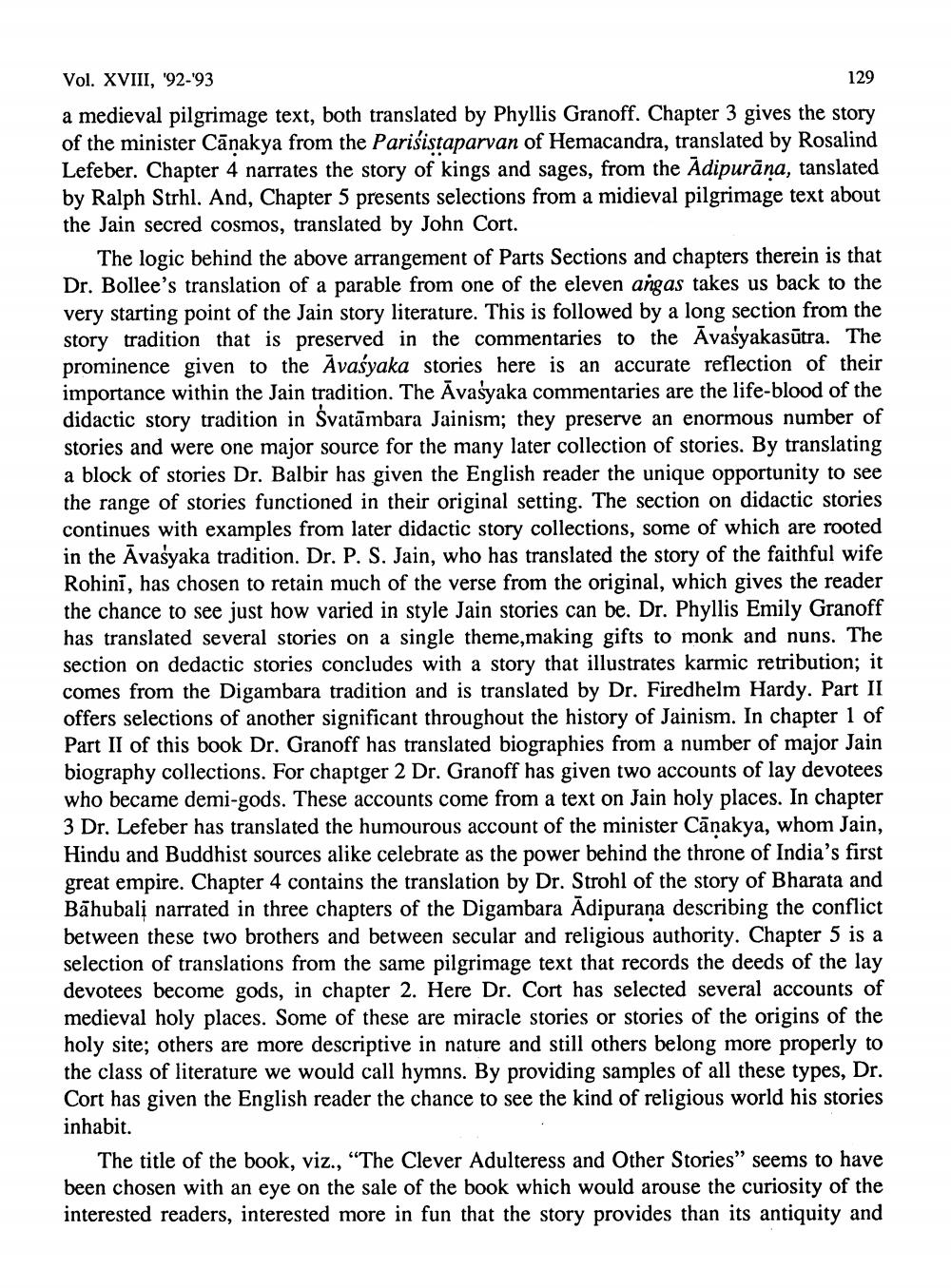________________
Vol. XVIII, '92-'93
129 a medieval pilgrimage text, both translated by Phyllis Granoff. Chapter 3 gives the story of the minister Cānakya from the Parisistaparvan of Hemacandra, translated by Rosalind Lefeber. Chapter 4 narrates the story of kings and sages, from the Adipurāna, tanslated by Ralph Strhl. And, Chapter 5 presents selections from a midieval pilgrimage text about the Jain secred cosmos, translated by John Cort.
The logic behind the above arrangement of Parts Sections and chapters therein is that Dr. Bollee's translation of a parable from one of the eleven angas takes us back to the very starting point of the Jain story literature. This is followed by a long section from the story tradition that is preserved in the commentaries to the Āvasyakasūtra. The prominence given to the Avaśyaka stories here is an accurate reflection of their importance within the Jain tradition. The Āvasyaka commentaries are the life-blood of the didactic story tradition in Svatāmbara Jainism; they preserve an enormous number of stories and were one major source for the many later collection of stories. By translating a block of stories Dr. Balbir has given the English reader the unique opportunity to see the range of stories functioned in their original setting. The section on didactic stories continues with examples from later didactic story collections, some of which are rooted in the Āvašyaka tradition. Dr. P. S. Jain, who has translated the story of the faithful wife Rohini, has chosen to retain much of the verse from the original, which gives the reader the chance to see just how varied in style Jain stories can be. Dr. Phyllis Emily Granoff has translated several stories on a single theme,making gifts to monk and nuns. The section on dedactic stories concludes with a story that illustrates karmic retribution; it comes from the Digambara tradition and is translated by Dr. Firedhelm Hardy. Part II offers selections of another significant throughout the history of Jainism. In chapter 1 of Part II of this book Dr. Granoff has translated biographies from a number of major Jain biography collections. For chaptger 2 Dr. Granoff has given two accounts of lay devotees who became demi-gods. These accounts come from a text on Jain holy places. In chapter 3 Dr. Lefeber has translated the humourous account of the minister Cānakya, whom Jain, Hindu and Buddhist sources alike celebrate as the power behind the throne of India's first great empire. Chapter 4 contains the translation by Dr. Strohl of the story of Bharata and Bāhubali narrated in three chapters of the Digambara Adipurana describing the conflict between these two brothers and between secular and religious authority. Chapter 5 is a selection of translations from the same pilgrimage text that records the deeds of the lay devotees become gods, in chapter 2. Here Dr. Cort has selected several accounts of medieval holy places. Some of these are miracle stories or stories of the origins of the holy site; others are more descriptive in nature and still others belong more properly to the class of literature we would call hymns. By providing samples of all these types, Dr. Cort has given the English reader the chance to see the kind of religious world his stories inhabit.
The title of the book, viz., "The Clever Adulteress and Other Stories" seems to have been chosen with an eye on the sale of the book which would arouse the curiosity of the interested readers, interested more in fun that the story provides than its antiquity and




